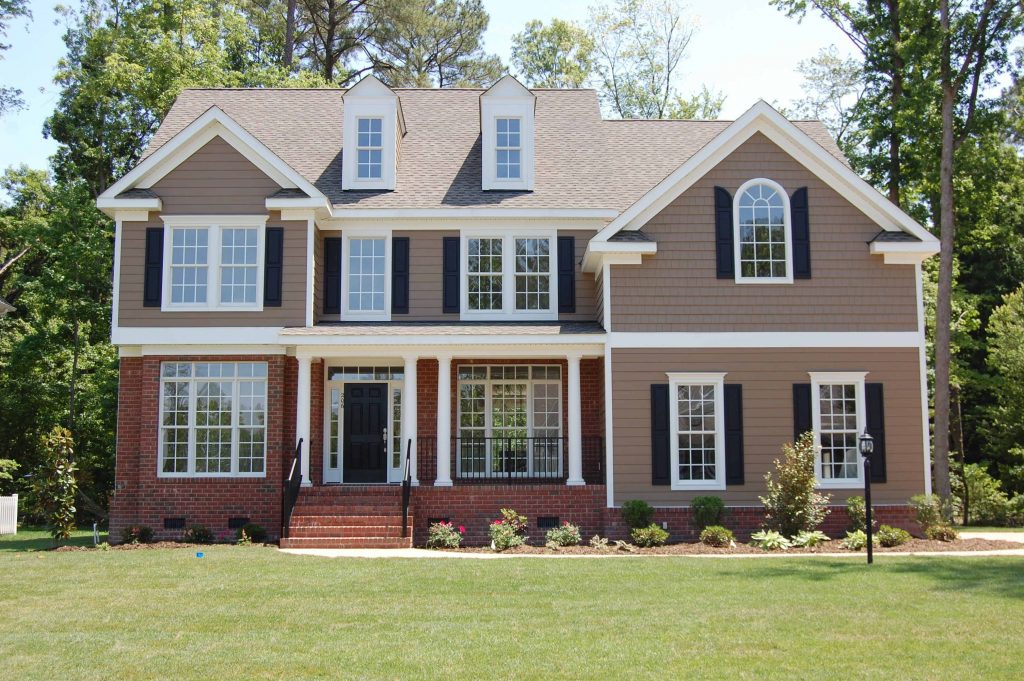When you paint your home’s exterior there is a choice between flat and satin sheens, and since the exterior is subjected to major stresses, including rain, ice, UV rays, and physical wear (maybe by children), this decision is important.
The various sheen levels of paint are determined by the ratio of resins and binders to pigment levels in the paint. Paints with a high level of resins/binders create a high-sheen, shiny surface, while those where the pigment levels are high create a less reflective surface. Generally speaking, glossier paints are more durable, while flatter paints are less resilient but cover better.
There are four different sheen levels to choose from: flat (also called matte), satin (or low-lustre), semi-gloss and high-gloss. The ratio of resins/binders to pigments increases with each level.
For large areas of the home covered by siding, less glossy paints are a better choice, because you want to avoid shiny, glossy paints with highly reflective properties that will highlight each bump and imperfection. The choice, then, is between a flat (matte) paint or a satin/low-luster paint which is more forgiving of surface imperfections.
MATTE Paints on Exteriors
A flat paint has a non-reflective finish that will feel slightly chalky and rough when you run your hand across it. The caveat with flat paints is they really cannot be washed at all. You can scrub flat finish with TSP or pressure wash it, but often the best solution is to lay down another coat of paint. You can expect to repaint more often if you use flat paint.
Pros of exterior matte paint:
- No overlap marks. Whether brushed or rolled, the paint hides lap marks well.
- Modern, contemporary look when the paint is new.
- Hides flaws in the siding surface.
Cons of exterior matte paint:
- Difficult to scrub clean.
- Surface may become chalky, requiring more frequent repainting.
SATIN (low-luster) Paints on Exteriors
Satin finishes are relatively low in reflection, which means that they also do a decent job of hiding bumps and imperfections in the siding surface. The same paint color will appear slightly richer and luxurious in a satin sheen than it does in a matte sheen. Satin/eggshell finishes can be wiped down with water.
Satin paints require a bit more care during application in order to avoid lap marks. It is important to keep a wet edge during application and that the paints are thoroughly mixed before every painting application to keep the resins and pigments in uniform ratio throughout the can.
Pros of exterior satin paint:
- Satin finishes are more washable.
- The finish is longer lasting than flat paints.
Cons of exterior satin paint:
- Lap marks may be evident when painting.
- Sheen can be uneven unless the paint is mixed thoroughly. Have stored paint thoroughly mixed at the store before painting. Boxing the paint (mixing several cans together) can also solve this problem.
Semi-Gloss or Gloss for exterior surfaces?
It is advisable to use higher gloss only for trim and doors—surfaces that get a lot of wear and may need to be frequently scrubbed. Paints with a higher gloss are a logical choice where exterior trim will need to be washed frequently. Because of their reflective shininess every bump and imperfection is more visible, so they are not a good choice for large areas of siding.
Burke and Crew recommends a satin finish for the exterior of most homes. It satisfies basic upkeep objectives, while providing a pleasant appearance.
Original post by Lee Wallender


